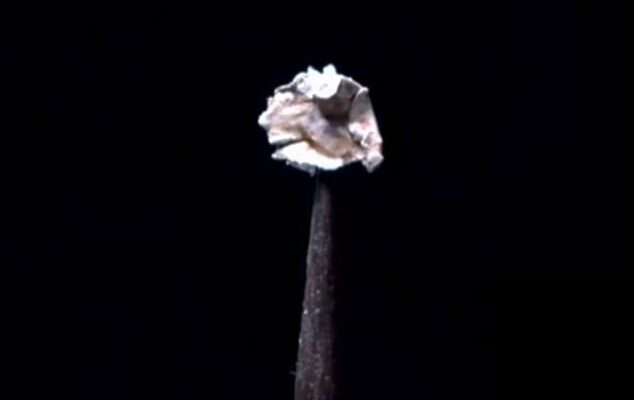America’s most famous UFO case is still producing more evidence as scientists and civilians are on a mission to prove that the Roswell crash was not of this world.
The 1947 incident made headlines when the US Army Air Force issued a press release stating that it had recovered debris from a ‘flying disc’ — only later to reverse course, claiming that the material had really just belonged to a downed weather balloon.
Geologist Frank Kimbler is among the many experts who have challenged the military’s official version of what crashed on the outskirts of this New Mexico town, where he has scoured the alleged UFO’s crash site with a metal detector since 2010.
Kimbler has since uncovered over 20 unusual scraps of metal material, most no bigger than a fingernail, and has now submitted one uniquely odd metal for testing to the Discovery Channel’s new series ‘Alien Encounters: Fact or Fiction.’
Testing revealed that the metal was ‘100-percent pure aluminum,’ which experts said was ‘compelling evidence’ that could prove aliens crashed in the area decades ago.
Geologist Frank Kimbler uncovered over 20 unusual scraps of metal material, most no bigger than a fingernail, and has now submitted one uniquely odd metal for testing to the Discovery Channel’s new series ‘ Alien Encounters: Fact or Fiction
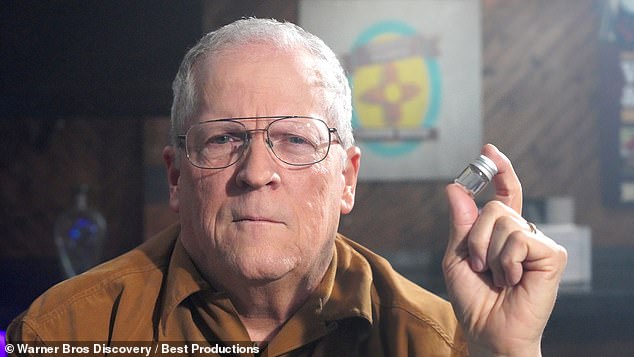
Kimbler (above with his possible UFO crash sample) had pulled this roughly quarter-inch metal fragment from an ant hill where the bugs had stored it. He submitted the aluminum sample for testing by the new Discovery Channel series
‘I was really trying to champion truth throughout,’ the new series’ cohost, Chrissy Newton, told DailyMail.com, adding that she was not afraid to debunk a few celebrated UFO cases, if that’s where the facts led.
‘I want to prove that it’s identifiable,’ Newton said, ‘not everyone’s gonna like that.’
Nevertheless, Newton found the tests on the pure aluminum mystery metal to be compelling, she said, in part because a former Pentagon UFO investigator has told her that ‘pure aluminum has been connected to multiple other UFO crash sites.’
While Newton did not name her Pentagon source, she described them as ‘a source formerly from AATIP,’ the US military’s Advanced Aerospace Threat Identification Program, which from 2007 to 2012 had been tasked (in part) with studying UFOs.
!['Most Al [aluminum] in use are anodized Al,' Dr Hossain noted, a process that creates a thin layer of aluminum, reacted with oxygen, to seal off the interior aluminum from rust-like degradation caused by reactions with the air. This sample, he said, had 'not been anodized'](https://allnewspress.com/deutsch/wp-content/uploads/2024/06/1718831118_167_New-compelling-evidence-found-at-Roswell-UFO-site-could-prove.jpg)
‘Most Al [aluminum] in use are anodized Al,’ Dr Hossain noted, a process that creates a thin layer of aluminum, reacted with oxygen, to seal off the interior aluminum from rust-like degradation caused by reactions with the air. This sample, he said, had ‘not been anodized’
Kimbler, who teaches earth sciences and geology at the New Mexico Military Institute, told Newton and her cohost that he had pulled this particular metal fragment, roughly a quarter-inch long, from an ant hill within the Roswell debris field.
Testing ant hills for ant-harvested metals, the geologist noted, has been a common tactic for gold prospectors, mining geologists, and metal detector hobbyists alike.
The insect colonies are known for collecting sturdy and sometimes buried materials for to build their tunnel systems, according to Jim Davis of Utah’s geology survey.
‘Thanks to the ant’s undertakings, prospectors have discovered rich lodes of gold, copper, nickel, turquoise, diamonds, and many other minerals,’ Davis said.
Over the years, Kimbler has been open that many of the metal fragments he’s recovered from the infamous crash site might have a more earthbound explanation.
‘Some of it could be trash, camper trash,’ he told KRQE in 2018 after the Bureau of Land Management caught wind of his hobby, ‘but some of it could be interesting.’
To confirm what Kimbler actually found, the new Discovery Channel series sent the metal sample for chemical testing via mass spectrometry to independent experts at the Texas-based firm Cerium Labs, which specializes is aluminum metallurgy.
Dr Tom Hossain, chief scientist at Cerium Labs, reported that the aluminum metal fragment was not only unusual for its purity, but it also differed from the typical industrial-grade aluminum used in manufacturing.
‘Most Al [aluminum] in use are anodized Al,’ Dr Hossain said.
Anodizing is an electrochemical process that converts the metal surface into a decorative, durable and corrosion-resistant finish known as an anodic oxide.
It protects the metal underneath that finish from corroding in reactions with the oxygen molecules present in both air and water.

The lead author of the Air Force’s 1994 Roswell report, Col. Richard Weaver, came forward in 2020 to discuss ‘a lot of manipulation going on behind the scenes’ of his official inquiry. Above, an image for a 90s television program about one of the many books about the crash, ‘The Day after Roswell’
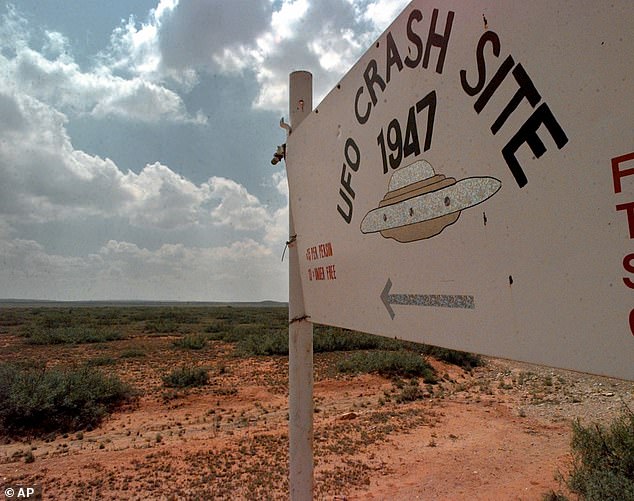
Kimbler, who teaches earth sciences and geology at the New Mexico Military Institute, said he had pulled this particular metal fragment from an ant hill within the Roswell debris field. Above, a sign directing Roswell visitors to the start of a ‘1947 UFO Crash Site Tour’ circa 1997
‘This is not an alloy,’ Dr Hossain wrote. ‘This is pure aluminum.’
Kimbler’s find joins a growing body of eyewitness testimony, and even declassified government records, that appear to indicate that the Roswell crash included some form of exotic metal materials.
More than 40 witnesses to the Roswell crash mentioned that a metal-like material from the site could ‘remember itself’ when folded or physically altered, according to UFO researcher Anthony Bragalia.
Bragalia obtained over 150 pages from the US Defense Intelligence Agency (DIA) in 2021 via a Freedom of Information Act (FOIA) request, which he said included telling new evidence about where this ‘memory metal’ may have ended up.
The records included pages that repeatedly mention ‘advanced technology reports’ surrounding Nitinol, described as a shape recovery alloy.
Nitinol had similar properties to the ‘memory metal’ found near the Roswell crash site, according to Bragalia.
Pages from the FOIA reply indicate that the Pentagon was exploring whether Nitinol could be integrated into the human body for the improvement of health, the researcher wrote at his blog, UFO Explorations.

Today, even the lead author of the Air Force’s official and final Roswell report in 1994, Colonel Weaver, has come forward to caution that the current official explanation is inconclusive: ‘Did we say it was 100-percent? No way. We didn’t say that’ (above, the military’s first explanation)
‘Although much of the reports’ details are redacted, what can be gleaned is that these technologies represent a literal quantum leap beyond the properties of all existing material known to man,’ Bragalia said.
‘Based on the documentation received,’ he added, ‘it appears that the retrieved debris exhibits other extraordinary capabilities.’
‘In addition to ‘remembering’ their original form when bent or crushed, some of these futuristic materials have the potential to make things invisible, ‘compress’ electromagnetic energy, and even slow down the speed of light,’ Bragalia said.

UFO researcher Tony Bragalia has argued that debris from the Roswell crash was flown to Wright Field in Greene County, Ohio, with Battelle Memorial Institute soon securing a contract to start remaking the UFO’s ‘memory metal’ Nitinol, using Nickel and ultra-high purity Titanium
Today, even the lead author of the Air Force’s official 1994 report, Colonel Richard Weaver, that revisited the Roswell case has come forward to caution that the military’s current official explanation is by no means conclusive.
‘Did we say it was 100-percent? Col. Weaver said on a 2020 podcast. ‘No way. We didn’t say that.’
Col Weaver also alluded ominously to ‘politics and a lot of manipulation going on behind the scenes’ of his 1994 inquiry, but added he is still confident in his report’s explanation – that a secret military spy balloon was what crashed at Roswell.
Not every case to come to the hosts of Discovery’s new ‘Alien Encounters’ reaches this level of fascinating physical evidence and documentation, however, as the show examines each submitted ‘alien encounter’ to the same high investigative standards.
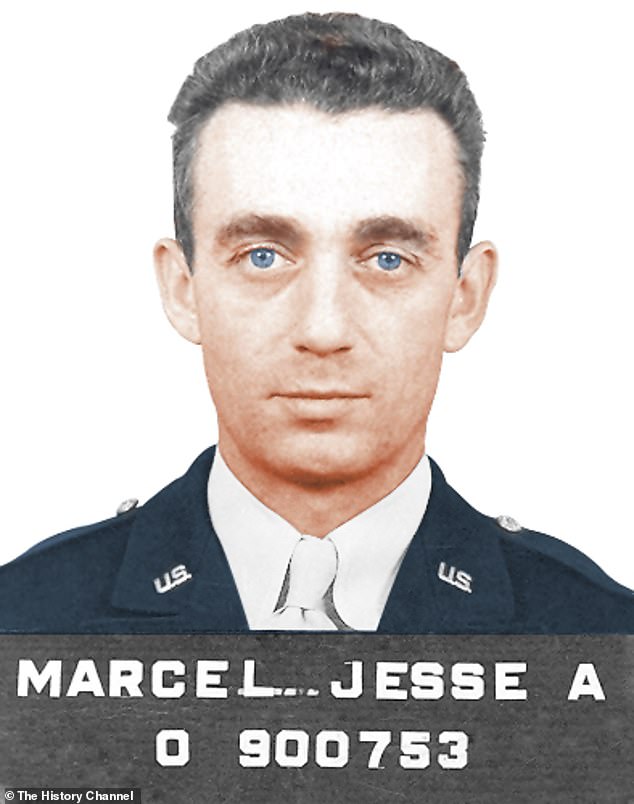
Roswell base intel officer Major Jesse Marcel (left) has claimed he was forced to pose before reporters with weather-balloon debris he did not witness at the Roswell UFO crash site. Major Marcel was portrayed by actor Kyle MacLachlan in a 1994 Showtime original TV movie, Roswell

Above, Major Marcel posing with that more prosaic crashed weather balloon debris (above)
The show’s premiere included two other cases: one proved to be explainable and the other appeared to remain a genuine mystery.
Posting up at The Variety, a long-standing local watering hole in Roswell, New Mexico, Newton interviewed multiple self-described UFO and alien ‘experiencers’ on camera to more thoroughly vet their stories.
Her cohost in this process, occult scholar and author Mitch Horowitz, called Kimbler an ‘inspiration’ for the local geologist’s willingness to ask ‘pure questions’ and for taking a proactive approach to investigating these unexplained events.
‘Along with Mitch, we both state our opinion, if we think it is a UFO or not,’ Newton told DailyMail.com. ‘But looking at the facts, [sometimes] there’s not strong enough data to even make a conclusion.’
Newton said Horowitz’s grounding in more social and cultural aspects of these phenomena complimented her own more scientific approach to their cases.
‘And also a female perspective, which I think is nice too,’ she said, ‘when talking to different experiencers.’
Newton is a partner in the tech news start-up The Debrief and a member of a civilian research group devoted to investigating UFOs, now more accurately known as ‘unidentified aerial phenomena’ (UAP), the Scientific Coalition of UAP Studies (SCU).
In recent years, the SCU has published a series of data-driven studies linking many military and police-reported UFO accounts to sensitive US nuclear weapons sites.
‘I’m always gonna follow the data, you know,’ Newton said, ‘being a member of the Scientific Coalition of UAP Studies.’
‘It’s really important for me to understand the data,’ she said, ‘like anybody else that really loves the science behind it.’

The new series’ cohost Chrissy Newton (right) is a partner in tech news start-up The Debrief and a member of a civilian group devoted to investigating UFOs, now more accurately known as ‘unidentified aerial phenomena’ (UAP), called the Scientific Coalition of UAP Studies
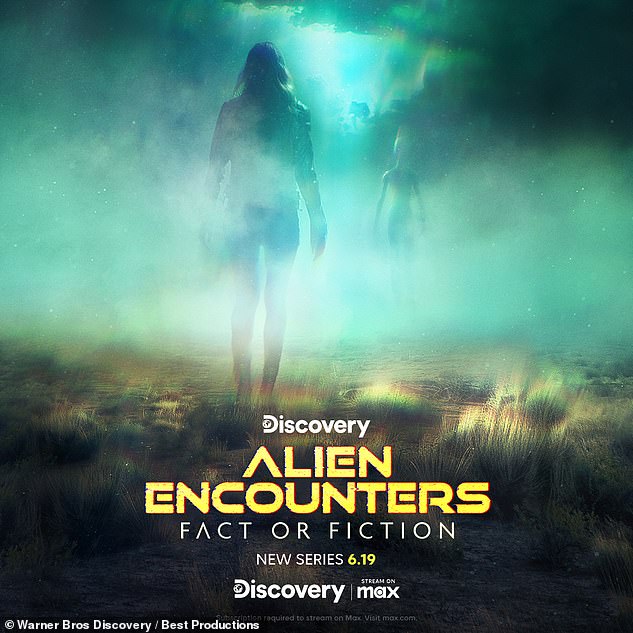
‘Alien Encounters: Fact or Fiction’ premieres tonight, Wednesday, June 19, at 10PM Eastern and Pacific on the Discovery Channel. Shortly after, the series will be available to stream on Max
Newton said she joined up with the new docuseries’ producers in an effort to help bring her years of experience interviewing scientists and academics on her podcast for The Debrief, Rebelliously Curious, to good use investigating more UFO cases.
‘I think they came to me because I have interviewed people from all different degrees, obviously academics and scientists with my podcast, and I’ve been around so many different UAP experiencers’ Newton told DailyMail.com.
In episodes to come, ‘Alien Encounters’ teases that the show will dig into a potential alien abduction experienced be two friends driving in California, an incredible UFO documented by a woman hiking Machu Picchu in Peru, and still more baffling cases.
But Newton emphasized that even those cases she and her colleagues prove to be ordinary are just as important as the cases that could be extraordinary.
‘We want to identify UFOs,’ Newton said. ‘It makes it easier then for us to weed through the other data from UFOs that we can’t explain.’
‘To identify something and say, ‘this is the ISS’ [the International Space Station] or ‘this is a Starlink satellite,” she noted, ‘that gives us better analytics and tools, better science and technology that other experts can look at.’
‘Alien Encounters: Fact or Fiction’ premieres tonight Wednesday, June 19 at 10PM ET/PT on the Discovery Channel. Soon after, the series will be streaming on Max.

